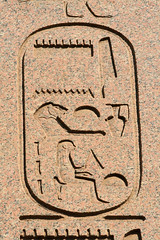A project to locate all possible Hatshepsut- related artifacts in museums and sites all over the world. Also to serve as an information sharing blog on all things Hatshepsut.
Hatshepsut Project Tabs
Search HATSHEPSUT PROJECT
Wednesday 24 November 2010
Hatshepsut's Rock Cut Tomb
I am pleased to report that Richard has also kindly posted photos of Hatshepsut's rock cut tomb
on Jane's blog. Now this is not KV20. Before becoming Pharaoh, Hatshepsut began making a "fitting" tomb for herself. When Hatshepsut became Pharaoh, the rock- cut tomb was no longer suitable. The Valley of the Kings, KV20 was the replacement.
Hatshepsut's rock cut tomb does not contain Hieroglyphs or what some call treasure (gold, jewelery, etc). For those working in Egypt- information is treasure. The main source of information within this tomb comes from a Sarcophagus (now in the Egyptian Museum, Cairo), discovered by Howard Carter.
The inscriptions, titles given and the apparent abandonment allows us to see a small part of the life of Hatshepsut. A transition period, from Kings Daughter to Pharaoh. For further reading, please see:
Maat-Ka-Ra-Hatshepsut - Tomb description, diagram, photos, inscriptions (Go to Site Map, Cliff Tomb)
Egyptopia.com- Sarcophagus
Regards,
Stuart
Saturday 20 November 2010
Photo - Doorway Comparison

Please see my last post, to understand the title of this one.
Here is the same area, with restoration work clearly visible. And this is a very small part of a large temple. The love, care and effort shown by those of history and those today is truly admirable. it's a shame the Internet wasn't introduced 100 years earlier. Can you just imagine the footage we would have today?
Regards,
Stuart
Deir el Bahri, Upper Platform, Central Court from within Pylon and Coptic Tower

Deir el Bahri, Upper Platform, Central Court from within Pylon and Coptic Tower
Originally uploaded by The Egypt Exploration Society
If you were ever wondering what Deir el Bahri looked like before most of the restoration work was carried out - here is a glimpse.
Hardly recognisable with the beautifully restored temple we see today, the restoration work was no less than a huge jigsaw, with many parts missing.
The clearance work carried out to get to the stage we see in the photo would have taken months of clearing sand and fallen rock (from the cliff side behind the temple)
The photo is undated, but was taken by the Egypt Exploration Fund (now called Egypt Exploration Society), who were carrying out the excavation and restoration of the temple.
The doorway we see in this photo reminds me a bit of Stonehenge, here in England. I will post another picture of the same doorway later to show what wee see today.
Regards,
Stuart
Wednesday 10 November 2010
Photo - Hatshepsut's Birth Name

Karnak Temple 50
Originally uploaded by ruthhallam
Carved beautifully out of red/pink granite and located within the Temple complex of Karnak in Luxor, we have the birth name of Hatshepsut.
The cartouche reads "Foremost of Noble Women, United with Amun".
Regards,
Stuart
Tuesday 9 November 2010
KV20 Photos - Jane Akshar, Luxor News
If you would like to know more, see Maat-Ka-Ra-Hatshepsut,
Regards,
Stuart
Saturday 6 November 2010
Senenmut - The Kimbell Art Museum
This is a chance for me to be able to show a Statue of Senenmut, Chief Steward of Queen Hatshepsut.
Two things stand out for me when looking at this statue:
1) - The material used - Gray green schist - is one of my favourite of the stone materials used in Ancient Egypt. I will post a photo of Thutmose III i have (at a later date) which could be my favourite Ancient Egyptian statue. This too is made of schist.
2) - The Rebus -
"A rebus is a message spelled out in pictures that represent sounds rather than the things they are pictures of: for example, the picture of an eye, a bee and a leaf in English might be used to make the English sentence "I Believe," or "eye-bee-leaf." The sentence itself has nothing to do with eyes, bees or leaves".from: Tour Egypt
The Rebus in this case is the throne name of Hatshepsut, Maat Ka Ra. The upturned arms (Ka) at the foot of the snake (Maat)and the sun (Ra) between the horns atop of the head of the snake.
Regards,
Stuart
Wednesday 3 November 2010
Hatshepsut - Royal Ontario Museum (Toronto, Canada)

Royal Ontario Museum (Toronto, Canada)
Originally uploaded by md.faisalzaman
Something a bit different. This is a cast of the Deir el Bahri Punt Expedition, which can be found at the Royal Ontario Museum (Toronto, Canada).
As Egyptology progresses, we hear of the many attempts to recreate tombs so that studies can be made outside of Egypt and also to protect the tombs themselves. Casts which were made of tombs (and temple)decoration before the recognition of conservation may in some occasions have damaged the wall decorations they were intending to cast.
Today things are different, as we have seen in the Valley of the Kings (restoration work, the closing of tombs, etc). It would be nice to think that there will be whole temples reconstructed in museums around the world, so that those who may never see the monuments for themselves can still experience every hieroglyph, pillar, pylon, etc.
Who knows?
Regards,
Stuart